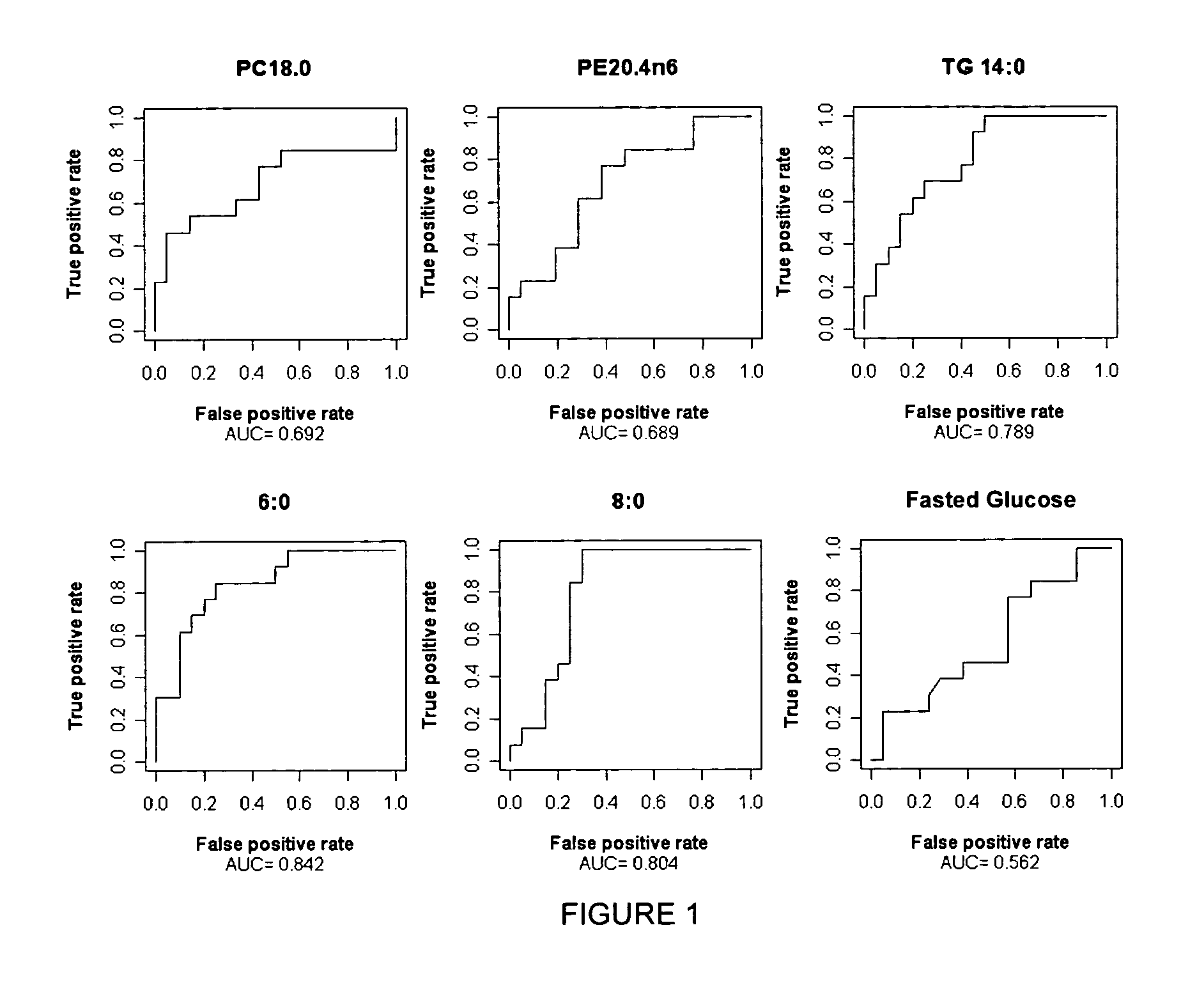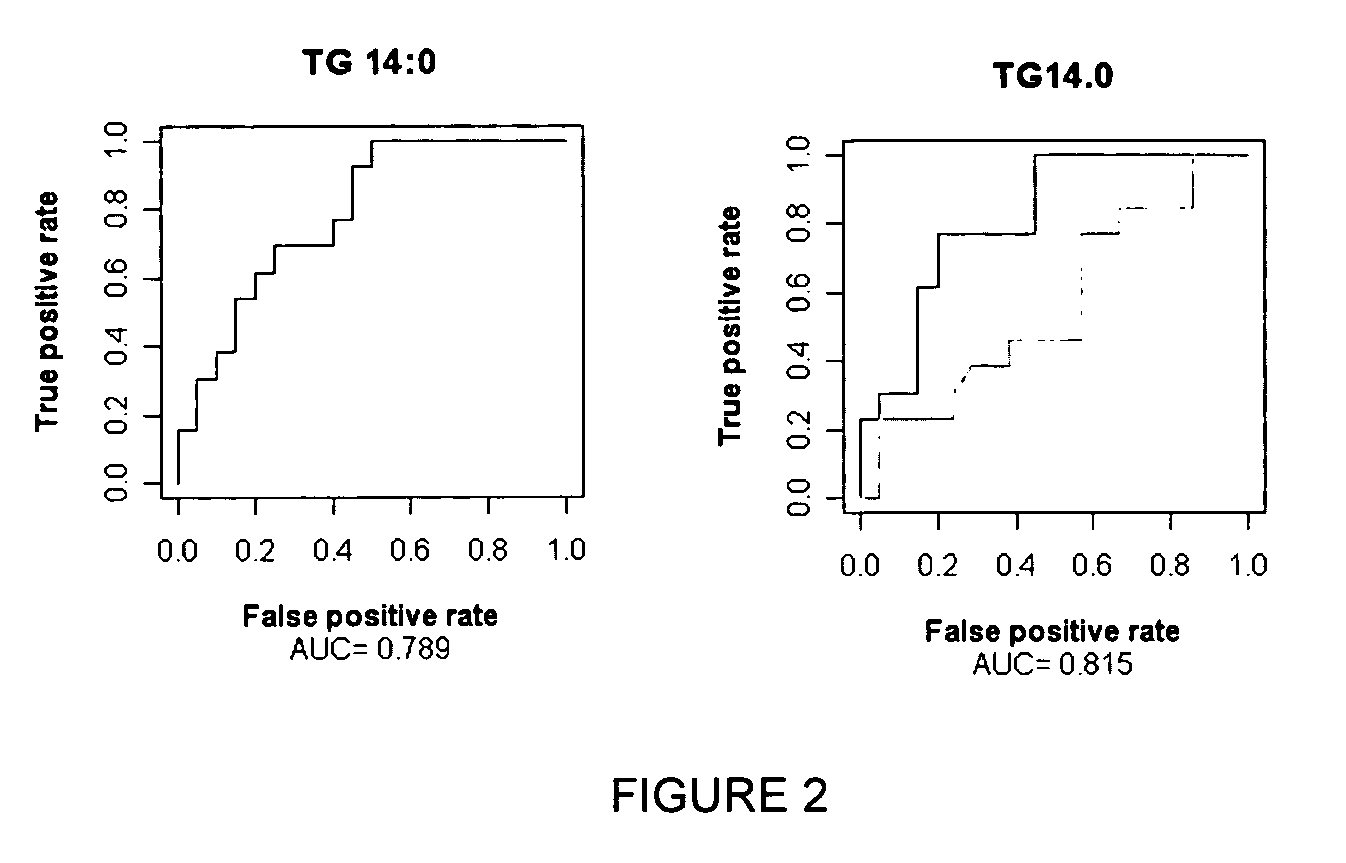Metabolic markers of diabetic conditions and methods of use thereof
- Summary
- Abstract
- Description
- Claims
- Application Information
AI Technical Summary
Benefits of technology
Problems solved by technology
Method used
Image
Examples
example 1
Lipid Metabolites Provide Improved Assessment of Glucose Intolerance from a Fasted Blood Sample
Protocol and Methods
[0100]Twenty-five volunteers, nine young (five female, four male; ages 20-32 yr) and 16 elderly (11 female, five male; ages 65-74 yr) subjects, were enrolled in the study. Both groups were equally multiracial, with six Caucasians, two Hispanics, and one African-American in the young group and 12 Caucasians, three Hispanics, and one African-American in the elderly group. All volunteers were healthy by history and physical examination, and none were participating in regular aerobic or resistance training routines. Subjects' total cholesterol was less than 250 mg / dl (6.5 mmol / liter), and TSH levels were within the normal range (0.49-4.70 μIU / ml). Further exclusions included palpable liver enlargement; positive hepatitis B, C, or HIV tests; anemia; or elevation in level of more than one of the following: alkaline phosphatase more than 122 U / liter, alanine aminotransferase m...
example 2
Markers of PPARs-Gamma Agonist Treatment Provide Diagnostic Tools for Treatment Efficacy and the Reversal of Diabetic Conditions
Rationale
[0118]As demonstrated above, several plasma lipid metabolites provide better prediction of AUC glucose than fasted glucose and others add predictive value to fasted glucose measurements. Thus, lipid metabolism is playing an important role in glucose intolerance and other diabetic conditions. This fact is underscored by the fact that clinical treatment protocols for diabetic conditions employ drugs including thiazolidinediones, fibrates and statins that have profound effects on lipid metabolism. In particular, the group of agents known as PPARs agonists improve insulin resistance and diabetic conditions by altering lipid metabolism pathways and thus may produce changes in plasma lipid metabolite concentrations that will be useful as diagnostic tools for monitoring the efficacy of PPARs agonists in reversing diabetic conditions.
[0119]There are three ...
example 3
Markers of PPARs-Alpha and Delta Agonist Treatment Provide Diagnostic Tools for Treatment Efficacy, Safety and the Reversal of Diabetic Conditions
Study Overview
[0143]A clinical study examining the effect of 12-week treatment with a PPARs-delta modifying agent (5 mg / 10 mg) and PPARs-delta modifying agent (20 mg) as compared to placebo was performed in 57 subjects. Plasma samples were obtained at pre-dose and after 28, 42 and 84 days of treatment. Lipomics determined the concentration of lipid metabolites from each time point in the trial and evaluated the changes in lipid metabolite concentrations for markers of treatment efficacy, safety and the reversal of the diabetic condition.
[0144]Lipids measured included cholesterol, cholesterol esters (CE), diglycerides (DG), free cholesterol (FS), free fatty acids (FA), lysophosphatidylcholine (LY), phosphatidylcholine (PC), phosphatidylethanolamine (PE) and triglycerides (TG). For CE, DG, FA, LY, PC, PE and TG lipid classes the following fa...
PUM
| Property | Measurement | Unit |
|---|---|---|
| Time | aaaaa | aaaaa |
| Pressure | aaaaa | aaaaa |
| Electrical resistance | aaaaa | aaaaa |
Abstract
Description
Claims
Application Information
 Login to View More
Login to View More - R&D
- Intellectual Property
- Life Sciences
- Materials
- Tech Scout
- Unparalleled Data Quality
- Higher Quality Content
- 60% Fewer Hallucinations
Browse by: Latest US Patents, China's latest patents, Technical Efficacy Thesaurus, Application Domain, Technology Topic, Popular Technical Reports.
© 2025 PatSnap. All rights reserved.Legal|Privacy policy|Modern Slavery Act Transparency Statement|Sitemap|About US| Contact US: help@patsnap.com


